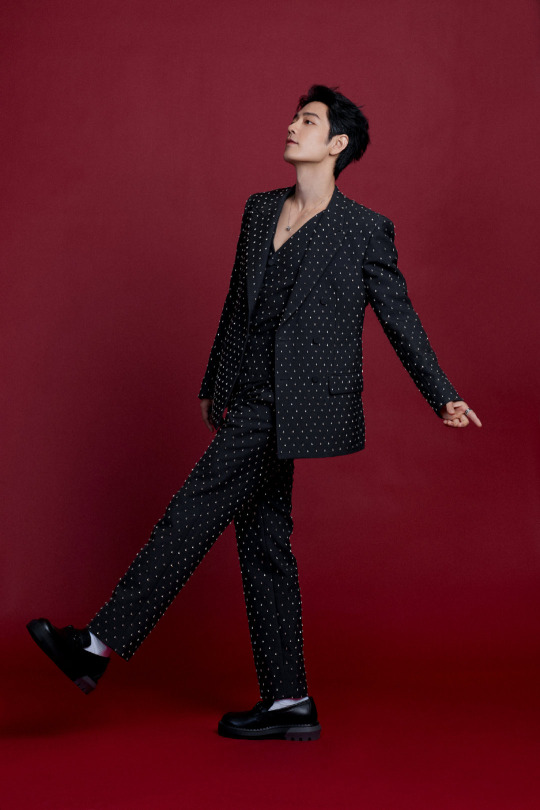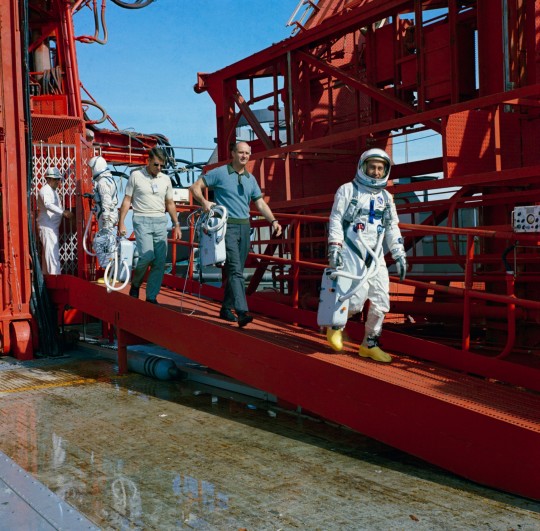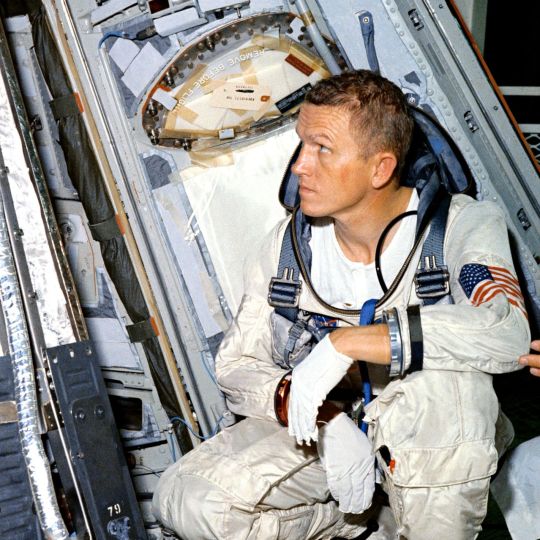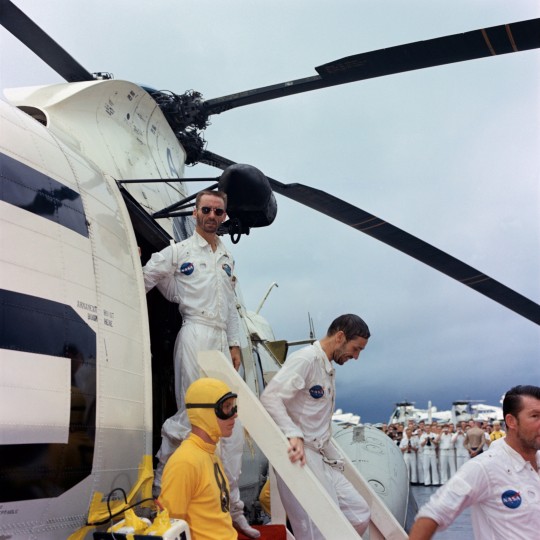#walter schirra
Text

Newly chosen astronauts (left to right) Neil Armstrong, Frank Borman, James Lovell, Thomas Stafford, Charles Conrad, John Young (kneeling), Edward White, and James McDivitt watch the launch of Walter Schirra aboard Mercury-Atlas 8, in the next-to-last mission of the Mercury program.
#neil armstrong#frank borman#james lovell#thomas stafford#charles conrad#john young#edward white#james mcdivitt#walter schirra#nasa#nasa photos#nasa pictures#nasa astronaut#astronaut#history#historical photography#1960s#rocket launch#60s#spacecraft#space flight#space history#space trip#mercury atlas 8#space travel#astronauts#nasa astronauts#nasa mission#mercury program#fly me to the moon
68 notes
·
View notes
Text

0 notes
Text
RIP Walter Cunningham, chosen in 1963 as one of "The Fourteen" and was LMP on Apollo 7. He spent a total of 10 days 20 hrs and 8 mins aboard the first manned Apollo mission to launch successfully in 1967.

Source: Wikipedia
Credit: NASA
0 notes
Text
Elle Thailand - GG's looks for Weibo Night
(source)
Straight from the runway! Revealing details of Xiao Zhan's special tailored look at Weibo Night 2023

The awards ceremony of the year in China, Weibo Night 2023, has ended. This event was an event that gathered many Chinese celebrities. both senior actors Actors who have worked this year Including many rising stars The same goes for actor Xiao Zhan, who also appeared at the event. Which he comes with 2 very special looks. L therefore did not miss the opportunity to unpack the details of his outstanding looks for fans to see. Let me tell you that each look is special and also reinforces the young man's popularity as a global brand ambassador. This person really is!


Custom Made Gucci
For the first look on the red carpet at the awards ceremony. The global ambassador for Gucci wore a custom outfit created by the brand's new creative director, Sabato De Sarno. The look was a classic black suit. Embellished with sparkling crystals inspired by the Menswear Fall/Winter 2024 collection that just ended at Milan Fashion Week. Complete with sparkling accessories from Boucheron, who is also the brand's global ambassador. Which with this brilliance also makes the hashtag 'Xiao Zhan twinkling' is trending at number one in the hot search on Weibo while the awards ceremony is going on. Gucci Menswear Fall/Winter 2024 / imaxtree



The One and Only Zenith ICONS
For the second look, he chose to wear a white swallow pattern suit from Balmain and completed the look with a 1971 Zenith ICONS watch, the same model that astronaut Walter Schirra first owned. Not only that The watch that Xiao Zhan wears in this look is the first and only watch currently available in China. It can be said that it is a special look and truly worthy of being a famous actor in the land of dragons.



In addition to the outstanding look that must be looked at He also created an impressive moment by winning the important award of the event, Outstanding Actor, together with two talented senior actors, Ma Li and Lei Jia Yin. Because of this, Xiao Zhan avoided being in the middle to respect the senior actors. But it turned out that the two senior actors wanted him to be in the middle. As a result, there was a very cute moment on stage that everyone was concerned with. But in the end, he had to be in the middle and be the first to say the thank you speech. And after this incident happened This moment immediately became viral in the Chinese online world. Because everyone admired this young man's cuteness and also admired his politeness. Seeing this, it is no wonder why he has become a favorite of fans all over the world because Xiao Zhan is truly handsome and cute.
Patnakan A - 15 January 2023
68 notes
·
View notes
Text

Astronauts John W. Young, Walter M. Schirra Jr., Thomas P. Stafford and Virgil I. Grissom (left to right) are shown during egress training during Gemini-Titan III (GT-3) simulation launch at Pad 19.
Date: November 24, 1964
NASA ID: S64-40298
#GT-3#GT-III#Gemini 3#Gemini III#SC3#Molly Brown#NASA#Gemini Program#Project Gemini#Gemini Titan#rocket#Titan II#Titan II GLV#LC-19#Cape Canaveral#Kennedy Space Center#Florida#62-12558#Virgil Ivan Grissom#Gus Grissom#John Watts Young#John Young#November#1964#my post
67 notes
·
View notes
Text

March 1, 1924... remembering Donald “Deke” Slayton
Would be 100th birthday for USAF pilot/astronaut Donald "Deke Slayton, selected a NASA astronaut in 1959, USAF Captain Donald Slayton became one of the original Mercury 7 astronauts. However centrifuge training electrocardiodiagrams pointed out he had a heart condition, so he became chief of the astronaut office, deciding on crew planning for the Gemini and Apollo programs.
In March 1972, NASA announced that Slayton had returned to flight status and in this way he became DMP - Docking Module Pilot for the historic Apollo-Soyuz Test Project in July 1975.
Wristwatch-wise, Donald Slayton wore a lot of watches (Accutron, Breitling, Bulova, Omega,...) and he was the first of the NASA astronauts to be spotted wearing an Omega Speedmaster CK2998-4 in December 1962. By June 1963, three NASA astronauts (Donald Slayton, Walter Schirra & Leroy Cooper) had a personal Speedmaster CK2298. Although bezelless since June 1963, Slayton kept wearing his Speedmaster CK2298 untill June 1965.
Note in this 1991 portrait, Donald Slayton wore his Gold "Apollo 11" tribute Omega Speedmaster BA 145.022-69 n° 27 chronograph on yellow Gold bracelet awarded in November 1969.
(Photo: Pam Francis portraits)
#Apollo#Astronaut#321#chronograph#Speedmaster#Moonwatch#MoonwatchUniverse#NASA#military#montres#uhren#pilot watch#test pilot#Speedytuesday#Omega#spaceflight#Zulu time
27 notes
·
View notes
Text

On Christmas Eve 1968, as commander of Apollo 8 – the first manned lunar orbital mission – Frank Borman, who has died aged 95, came out with words that, alongside Neil Armstrong’s “giant leap for mankind”, from Apollo 11 in 1969, and Jack Swigert and Jim Lovell’s “OK, Houston, we’ve had a problem”, from Apollo 13 in 1970, defined an era.
In that moment before the moon programme became mundane, when astronauts were prime time, Apollo 8’s broadcast ended with the crew – Bill Anders, Lovell and Borman – reading the story of Earth’s creation as written in the book of Genesis.
It was Borman’s conclusion, “Good night, good luck, a merry Christmas and God bless all of you, all of you on the good Earth”, that clinched it. For Gene Kranz, Nasa’s chief of flight control operations in Houston, the phrase was “literally magic. It made you prickly. You could feel the hair on your arms rising, and the emotion was just unbelievable.”
Thus, for some, the traumatic 1968 of the ongoing Vietnam war, the assassinations of Martin Luther King and Robert Kennedy, and the crushing of Czechoslovakia, had been transcended. From a distance – around 238,855 miles – it was still, apparently, the good Earth.
Around two years earlier, Nasa had been in crisis. On 27 January 1967, Gus Grissom, Ed White and Roger Chaffee had been incinerated on Apollo 1 during a test launch. Borman was appointed to the Nasa board which, that April, reported on the fire, slamming Nasa management and North American Aviation for its “ignorance, sloth and carelessness”.
Borman was then sent to North American’s plant in Downey, California – where drunkenness had been rife – to scrutinise command module redesign. “Borman set them straight,” wrote the second man on the moon, Buzz Aldrin, in Men from Earth (1989). “His shoot-from-the-hip management style – some called it bullying – worked.”
The Mercury programme had put astronauts in space. Gemini – to which Borman had been recruited in 1962 – had honed the business of Apollo: to fulfil President John F Kennedy’s goal of a manned moon landing by the end of the decade. In December 1965, Borman and Lovell had made their space debut with a record 14 days of orbit on Gemini 7, and also made a rendezvous with Gemini 6.
In the wake of the 1967 tragedy there were three unmanned Apollo launches, with mixed results. But in September 1968 the unmanned Soviet Zond 5’s orbit of the moon triggered alarm in the US. The Soviets had launched Sputnik, and the space age, in 1957. The first man in space, Yuri Gagarin, had orbited Earth in April 1961. That, along with the furore around the Bay of Pigs fiasco, had helped propel JFK into making his rash pledge in May 1961.
Seven years on, in autumn 1968, Nasa and the CIA were asking whether history was going to repeat itself. Would a Russian be first around the moon? That October, the Apollo 7 astronauts, Wally Schirra, Walter Cunningham and Donn Eisele, spent a successful, albeit cold-ridden and fractious, 10 days in orbit around the Earth. There were rows with ground control. None of those three would get another mission.
Nasa needed a breakthrough. Rather than the next planned Earth orbit, Apollo 8 was to be sent to the moon and, after the astronaut Jim McDivitt turned down the offer, Borman got the job. On 21 December, following a morale-boosting visit from the aviator Charles Lindbergh, Borman, Lovell and Anders blasted off.
Borman’s greatest fear, wrote Andrew Chaikin in A Man on the Moon (1994), was that the moon mission would be aborted and Apollo 8 would be confined to orbiting the Earth. It did not happen, but en route Borman was afflicted by vomiting and diarrhoea, the detrital consequences of which floated on, to be trapped by paper towels. The three men orbited the moon 10 times in 20 hours, descended to 69 miles above the rock’s surface, and were the first to witness the far side of what Borman called “a great expanse of nothing”.
It was on the fourth orbit that Borman spotted the Earth rising from behind the moon – an image that Anders captured on colour film and became known as Earthrise. “Oh my God! Look at the picture over there. Here’s the Earth coming up,” Borman is recorded shouting in a transcript.
Born in Gary, Indiana, Frank was the son of Edwin Borman, who ran an Oldsmobile dealership, and Marjorie (nee Pearce). The family moved to Tucson, Arizona, where his mother opened a boarding house, and Frank went to the local high school. He first flew as a teenager, in 1943. Seven years later he graduated from West Point Military Academy in New York state.
From 1950 Borman flew F-84 fighter-bombers with the US Air Force. A perforated ear drum denied him Korean war combat experience. In 1957 he gained a master’s in aeronautical engineering from the California Institute of Technology and became an assistant professor of thermodynamics and fluid mechanics at West Point.
Three years later he graduated from the Aerospace Research Pilot School at Edwards air force base in California. There, his aircraft included the controversial Mach 2 Lockheed F-104 Starfighter. It was in 1962 that, alongside Armstrong, Lovell and others, he became one of Nasa’s Gemini programme “New Nine”. Apollo 8 proved what had been evident to insiders for many years: that the US had won the space race. Borman, Anders and Lovell became Time magazine’s 1968 men of the year.
Having achieved the rank of colonel in the mid-1960s, Borman retired from the USAF and space flight and, after a sojourn at Harvard Business School, joined Eastern Air Lines. By 1975 he was Eastern’s CEO and a year later became chairman. But by the late 70s competition was intensifying, labour relations were deteriorating and Borman – never a diplomat – was in the firing line. He quit the company in 1986 when it was taken over by a corporate raider, and Eastern collapsed five years later.
He and his wife, Susan (nee Bugbee), whom he had married in 1950, moved to New Mexico, where he remained involved in business interests. They later settled in Billings, Montana, where he had a cattle ranch and rebuilt vintage aircraft. A supporter of Richard Nixon and both George Bushes, Borman was a man of brisk views. Among the many targets of his ire were the sound barrier-breaking pilot Chuck Yeager, the Democratic party presidential candidate Michael Dukakis and the scientist Carl Sagan.
He received many honours, including the Congressional Space Medal of Honor in 1978, and published his autobiography, Countdown, in 1988.
Susan died in 2021. His sons, Frederick and Edwin, four grandchildren and six great-grandchildren survive him.
🔔 Frank Frederick Borman II, astronaut, born 14 March 1928; died 7 November 2023
Daily inspiration. Discover more photos at Just for Books…?
12 notes
·
View notes
Text

An interesting thought I had today regarding the puzzlement of the five Tracys ages/placement in regard to the TOS order.
Normally, parents tend to put their children in birth order from oldest to youngest. This is not done in TAG or the 2004 movie, which has them in Thunderbirds order.
TOS they’re not.
So I did some digging on the actual Mercury 7 astronauts' birthdates and see if there was any tie in to parallel them.
Sure enough - in that order John and Gordon are placed correct as oldest and youngest to their real life counterparts. John Glenn was born July 18, 1921 and Leroy Gordon Cooper was born March 6, 1927.
That said, the middle three wouldn't be the three they were named - Scott, Virgil and Alan, if they went by their birthdates.
It'd been Walter (Wally), Alan and Donald (Deke) if Gerry Andersen had went by their namesakes' actual birthdates.
Wally Schirra was born March 12, 1923, Alan Shepard Nov. 18, 1923 and Deke Slayton was born March 1, 1924.
Malcolm Scott Carpenter was born May 1, 1925 and Virgil “Gus” Grisson was born April 3, 1926 to round out the seven.
.....
So a theory, and it IS theory which folks can take or leave given I'm tired and just want to do something fun:
I wonder if Anderson had originally considered going by the oldest and youngest of the Mercury 7, and then the next three oldest, but then seeing the names, just went with more timeless names Scott, Virgil and Alan. (Virgil keeping his original name to clearly show the tie-in to the Mercury group, as Gus Grisson hated his original name and NASA didn't want to use his middle - Ivan - due to the Space race with Russia.)
Alan does sound older however than Gordon in the pilot, not to mention the hairstyles would match with an Alan being older dynamic, so it would make sense for him to still be photo layout wise older than Gordon, but then it was recast. John's sculpt is designed older so it still fits with the original story of who was the original leader/hero.
Given the style and temperament of the middle three however, their actual names fit their counterparts better.
Doesn't officially give them any birth order, but it may explain the photo order and why so much confusion on the order in TOS.
Seriously - Virgil/John being older debate aside, TAG does benefit with us knowing who is oldest to youngest in style of the characters, voice and vocalization of age.
2 notes
·
View notes
Text
0 notes
Link
The new year of 1969 dawned with optimism that NASA would meet President John F. Kennedy’s goal of landing a man on the Moon and returning him safely to the Earth. The previous year saw four Apollo missions, two uncrewed and two carrying three astronauts each, test different components of the lunar landing architecture, culminating with Apollo 8’s December flight around the Moon. Challenges remaining for the new year included testing the Lunar Module (LM) with a crew, first in Earth orbit, and then in lunar orbit, a flight that served as a dress rehearsal for the Moon landing that could take place on the following mission. With flights occurring every two months, engineers at NASA’s Kennedy Space Center (KSC) in Florida processed three spacecraft and launch vehicles in parallel. Recovering from the fire Left: The Apollo 1 crew of Virgil I. “Gus” Grissom, left, Edward H. White, and Roger B. Chaffee. Middle left: Liftoff of the first Saturn V on the Apollo 4 mission. Middle right: The Lunar Module for the Apollo 5 mission. Right: Recovery of the Apollo 6 Command Module. The years 1967 and 1968 proved turbulent for the world. For NASA, the focus remained on recovering from the tragic Apollo 1 fire in time to meet President Kennedy’s fast approaching end of the decade deadline. The fire resulted in a thorough redesign of the Command Module (CM) to reduce flammability risks and to include an easy to open hatch. Engineers also removed flammable materials from the Lunar Module (LM). In November 1967, the first flight of the Saturn V carried Apollo 4 on a nine-hour uncrewed mission to test the CM’s heat shield. Apollo 5 in January 1968 completed an uncrewed test of the LM so successful that NASA decided to cancel a second test. Although fraught with problems, the April 1968 flight of Apollo 6 tested the CM heat shield once again. Managers believed that engineers could solve the problems encountered during this mission and declared that the next Saturn V would carry a crew. Apollo 7 and 8 Left: Apollo 7 astronauts Walter M. Schirra, left, Donn F. Eisele, and R. Walter Cunningham on the recovery ship USS Essex following their 11-day mission. Right: The famous Earthrise photograph from Apollo 8. By October 1968, thorough ground testing of the Apollo spacecraft enabled the first crewed mission since the fire. Apollo 7 astronauts Walter M. Schirra, Donn F. Eisele, and R. Walter Cunningham successfully completed the 11-day test flight, achieving all mission objectives. In August, with LM development running behind schedule, senior NASA managers began discussions of sending Apollo 8 on a circumlunar flight, pending the outcome of Apollo 7. With that hurdle successfully cleared, astronauts Frank Borman, James A. Lovell, and William A. Anders orbited the Moon 10 times during Christmas 1968, taking a giant leap toward achieving the Moon landing. Left: At the White House, Apollo 8 astronauts Frank Borman, James A. Lovell, and William A. Anders present a copy of the Earthrise photograph to President Lyndon B. Johnson. Middle: Accompanied by Vice President Hubert H. Humphrey, Borman, Lovell, and Anders take a motorcade from the White House to the Capitol. Right: Borman, left, Lovell, and Anders address a joint meeting of Congress. With their space missions completed, the Apollo 7 and 8 crews remained busy with events celebrating their successes. On Jan. 3, 1969, TIME magazine named Apollo 8 astronauts Borman, Lovell, and Anders their Men of the Year for 1968. Kicking off a whirlwind of events, on Jan. 9, outgoing President Lyndon B. Johnson welcomed them to the White House, where he presented them with NASA Distinguished Service Medals. They in turn presented him with a copy of the famous Earthrise photograph. Accompanied by Vice President Hubert H. Humphrey, Borman, Lovell, and Anders rode in a motorcade down Pennsylvania Avenue to the Capitol where the astronauts addressed a joint meeting of Congress. From there, they proceeded to the State Department for a press conference, their day ending with a dinner in their honor at the Smithsonian Institution. Left: Apollo 8 astronauts James A. Lovell, left, Frank Borman, and William A. Anders wave to the crowds assembled along their parade route in New York City. Middle: Borman, Lovell, and Anders address a crowd at Newark airport. Right: In Miami’s Orange Bowl Lovell, left, Borman, and Anders lead the fans in the Pledge of Allegiance at Super Bowl III. On Jan. 10, New York City held a tickertape parade for Borman, Lovell, and Anders. Mayor John V. Lindsay presented them with Medals of the City of New York, after which they attended a luncheon at Lincoln Center, a reception at the United Nations, and dinner at the Waldorf-Astoria Hotel. The next day, in 15-degree weather, they spoke to a crowd of about 1,500 people at Newark Airport before boarding a plane for much warmer Miami, where on Jan. 12 they attended Super Bowl III, and led the Orange Bowl crowd in reciting the Pledge of Allegiance. Left: In Houston, Apollo 8 astronauts William A. Anders, left, Frank Borman, and James A. Lovell present an Earthrise photograph and flags of Texas to Governor John B. Connally, far right, and Mayor Louie Welch, hidden behind the photograph. Middle: Borman and his family in the parade through downtown Houston, with Lovell and Anders and their families following behind. Right: Lovell, Borman, and Anders wave to the crowds in the parade in Chicago. A crowd estimated at about 250,000 welcomed Borman, Lovell, and Anders home to Houston on Jan. 13. In a ceremony outside the Albert Thomas Convention Center, Mayor Louie Welch presented them with bronze medals for heroism, and the astronauts presented Welch and Texas Governor John B. Connally with plaques bearing Texas flags they had flown to the Moon as well as a framed copy of the Earthrise photograph. The astronauts took part in the largest parade in the city’s history. The next day, the city of Chicago welcomed Borman, Lovell, and Anders. An estimated 1.5 million people cheered them on their parade route to a reception where they received honors from city council. Left: The Apollo 7 Command Module and a Lunar Module mockup on a float in President Richard M. Nixon’s inauguration parade; Apollo 7 astronauts Walter M. Schirra, R. Walter Cunningham, and Donn F. Eisele preceded the float in an open-air limousine. Image credit: courtesy Richard Nixon Library. Right: Apollo 8 astronauts Frank Borman, left, James A. Lovell, and William A. Anders with President Nixon at the White House. On Jan. 20, Apollo 7 astronauts Schirra, Eisele, and Cunningham rode in President Richard M. Nixon’s inauguration parade in Washington, D.C. Their spacecraft and a LM mockup rode on a float behind them. Ten days later, the new President invited Apollo 8 astronauts Borman, Lovell, and Anders to the White House where he announced that Borman and his family would embark on an 18-day goodwill tour of eight European nations, starting on Feb. 2. Apollo 9 The LM remained the one component of the lunar landing architecture not yet tested by astronauts in space. That task fell to James A. McDivitt, David R. Scott, and Russell L. Schweickart, the crew of Apollo 9. They and their backups Charles “Pete” Conrad, Richard F. Gordon, and Alan L. Bean spent many hours in the LM simulators and training for the spacewalk component of the mission. Left: In preparation for the Apollo 9 spacewalk, astronaut Russell L. Schweickart tests the Portable Life Support System backpack in an altitude chamber at the Manned Spacecraft Center (MSC), now NASA’s Johnson Space Center in Houston. Middle: Schweickart trains for his spacewalk in MSC’s Water Immersion Facility. Right: Apollo 9 backup astronauts Richard F. Gordon, left, and Alan L. Bean train for the spacewalk in the KC-135 zero-gravity aircraft. Apollo 9’s 10-day mission would take place in the relative safety of low Earth orbit. After docking with the LM, the crew’s first major task involved the first spacewalk of the Apollo program and the only in-space test of the new A7L spacesuit before the Moon landing. McDivitt and Schweickart planned to enter the LM, leaving Scott in the CM. Schweickart and Scott would each perform a spacewalk from their respective spacecraft. Scott would only stand in the open CM hatch while Schweickart would exit via the LM’s front hatch onto its porch, translate over to the CM using handrails, retrieve materials samples mounted on the spacecraft’s exterior and return back to the LM, spending two hours outside. This spacewalk tested the ability of crews to transfer through open space, in case a malfunction with the tunnel or hatches between the two spacecraft prevented an internal transfer. The day after the spacewalk, McDivitt and Schweickart planned to undock the LM, leaving Scott in the CM, fly it up to 100 miles away, testing its descent and ascent stages before returning to Scott in the CM who would perform the rendezvous and docking. At NASA’s Kennedy Space Center in Florida, three views of the Apollo 9 rollout from the Vehicle Assembly Building to Launch Pad 39A. The first of the three vehicles in processing flow at KSC, Apollo 9 rolled out from High Bay 3 of the Vehicle Assembly Building (VAB) to Launch Pad 39A on Jan. 3, just 13 days after Apollo 8 launched from the same facility, causing relatively minor damage. Stages of the Apollo 9 Saturn V had arrived at KSC during the spring and summer of 1968, the LM arrived in June and the Command and Service Modules (CSM) in October. Workers completed stacking of the Saturn V in October, adding the Apollo spacecraft in early December. On Jan. 8, NASA announced Feb. 28, 1969, as the planned launch date for Apollo 9. Left: Apollo 9 astronauts James A. McDivitt, front, David R. Scott, and Russell L. Schweickart depart crew quarters for the ride to Launch Pad 39A for emergency escape training. Middle: Scott, left, Schweickart, and McDivitt in the White Room during the pad emergency escape drill. Right: Scott, left, McDivitt, and Schweickart pose with their mission patch following a press conference at Grumman Aircraft and Engineering Corporation in Bethpage, New York. Workers at the pad immediately began to prepare the vehicle for flight, including software integration tests with the Mission Control Center at the Manned Spacecraft Center (MSC), now NASA’s Johnson Space Center in Houston. On Jan. 15, the prime and backup crews conducted emergency egress training from their spacecraft at Launch Pad 39A. Launch controllers at KSC successfully completed the Flight Readiness Test, the final major overall test of the vehicle’s systems, between Jan. 19 and 22. During a Jan. 25 press conference at the Grumman Aircraft and Engineering Corporation in Bethpage, New York, manufacturer of the LM, the Apollo 9 astronauts provided reporters with an overview of their mission. Apollo 10 Assuming Apollo 9 met its objectives and the LM proved space worthy in Earth orbit, in May Apollo 10 would repeat many of those tests in lunar orbit, including flying to within nine miles of the Moon’s surface. Left: Apollo 10 backup astronauts L. Gordon Cooper, front, and Edgar D. Mitchell arrive in the vacuum chamber in the Manned Spacecraft Operations Building (MSOB) at NASA’s Kennedy Space Center in Florida for a Lunar Module (LM) altitude test. Middle: Engineers in the MSOB conduct a docking test between the LM and the Command Module (CM) docking test. Right: Engineers prepare the CM for an altitude test. In November 1968, just six months before the planned launch date, NASA officially named the Apollo 10 crew. The prime crew consisted of Thomas P. Stafford, John W. Young, and Eugene A. Cernan. All had flown Gemini missions and had recently served as the Apollo 7 backup crew. L. Gordon Cooper, Donn F. Eisele, and Edgar D. Mitchell served as their backups. Left: In High Bay 2 of the Vehicle Assembly Building at NASA’s Kennedy Space Center (KSC) in Florida, the three stages of the Apollo 10 Saturn V await the arrival of the spacecraft. Middle left: In KSC’s Manned Spacecraft Operations Building (MSOB), workers remove the Lunar Module (LM) from an altitude chamber. Middle right: Workers in the MSOB lower the LM onto the base of the Spacecraft LM Adapter (SLA). Right: After installing the main engine bell, workers lift the Command and Service Module for mating with the SLA. In the VAB’s High Bay 2, workers had completed stacking the Apollo 10 Saturn V’s three stages by the final days of 1968, while their colleagues prepared to roll Apollo 9’s rocket to the pad a few days later. In the nearby Manned Spacecraft Operations Building (MSOB), prime and backup crews completed altitude tests of the LM in December and workers conducted a docking test between the LM and the CM. On Jan. 16, Stafford, Young, and Cernan completed their altitude test of the CM, followed by Cooper, Eisele, and Mitchell the next day. Workers removed the spacecraft from the altitude chamber in preparation for its rollover to the VAB in early February for stacking onto the rocket. Apollo 11 Assuming Apollo 9 and 10 accomplished their objectives, Apollo 11 would attempt the first Moon landing in July. Should Apollo 11 not succeed, NASA would try again with Apollo 12 in September and even Apollo 13 in November or December. Spacecraft and rocket manufacturers continued building components to meet that aggressive schedule. Apollo 11 crew of Edwin E. “Buzz” Aldrin, left, Neil A. Armstrong, and Michael Collins. On Jan. 9, a mere six months before the planned launch date, NASA formally announced the Apollo 11 crew, the second all-veteran three-person crew after Apollo 10 – and the last all-veteran crew until STS-26 in 1988. The next day, NASA introduced the Apollo 11 crew during a press conference at MSC. The prime crew consisted of Neil A. Armstrong, Michael Collins, and Edwin E. “Buzz” Aldrin. Each astronaut had flown one Gemini mission. Armstrong and Aldrin had served on the backup crew for Apollo 8 while Collins was initially a member of the prime Apollo 8 crew until a bone spur in his neck requiring surgery sidelined him. He fully recovered from the operation, and NASA included him in the Apollo 11 crew. The Apollo 11 backup crew consisted of James A. Lovell, William A. Anders, and Fred W. Haise. Lovell and Anders had just completed the Apollo 8 lunar orbit mission with Haise a backup crew member on that flight. When Anders announced that he would retire from NASA in August 1969 to join the National Space Council, Thomas K. “Ken” Mattingly began training in parallel with Anders in case the mission slipped past that date. Left: The Lunar Module for Apollo 11 arrives at NASA’s Kennedy Space Center (KSC) in Florida. Middle: The Apollo 11 Command Module, left, and Service Module, in KSC’s Manned Spacecraft Operations Building shortly after their arrival. Right: The S-IVB third stage for Apollo 11’s Saturn V rocket arrives at KSC. Hardware began to arrive at KSC for Apollo 11. With the Apollo 10 CSM still undergoing testing in the MSOB, the Apollo 11 LM’s ascent and descent stages arrived Jan. 8 and 12, respectively, followed by the CM and SM on Jan. 23. Workers in the MSOB prepared the spacecraft for vacuum chamber testing. The Saturn V’s S-IVB third stage arrived on Jan. 19. Workers trucked it to the VAB where it awaited the arrival of the first two stages, scheduled for February. Lunar Receiving Laboratory Left: Schematic of the Lunar Receiving Laboratory (LRL) showing its major functional areas. Right: A mockup Command Module in the spacecraft storage area, part of the Crew Reception Area, in the LRL. With the Moon landing possibly just six months away, NASA continued to prepare key facilities designed to receive astronauts returning from the Moon. The 83,000-square-foot Lunar Receiving Laboratory (LRL), residing in MSC’s Building 37, was specially designed and built to isolate the astronauts, their spacecraft, and lunar samples to prevent back-contamination of the Earth by any possible lunar micro-organisms, and to maintain the lunar samples in as pristine a condition as possible. The building was completed in 1967, and over the next year, workers outfitted its laboratories and other facilities. A 10-day simulation in the facility in November 1968 found some deficiencies that NASA addressed promptly. On Jan. 23, 1969, workers brought a mockup Apollo CM into the LRL’s spacecraft storage area for fit checks. Left: Workers at the Norfolk Naval Air Station in Virginia hoist the Mobile Quarantine facility (MQF) onto the USS Guadalcanal. Middle: The flexible tunnel set up between the MQF and a mockup Command Module. Right: Workers in Norfolk load the MQF onto a C-141 cargo plane for the return flight to Ellington Air Force Base in Houston. An integral component of the back-contamination prevention process was the Mobile Quarantine Facility (MQF). Following lunar landing missions, the MQF housed astronauts and support personnel from their arrival onboard the prime recovery ship shortly after splashdown through transport to the LRL. Under contract to NASA, Melpar, Inc., of Falls Church, Virginia, converted four 35-foot Airstream trailers into MQFs, delivering the first unit in March 1968 and the last three in the spring of 1969. The first unit was used extensively for testing, with lessons learned incorporated into the later models. On Jan. 21, 1969, workers loaded the MQF aboard a U.S. Air Force C-141 cargo plane at Ellington Air Force Base near MSC to transport it to the Norfolk Naval Air Station in Virginia. Six recovery specialists from MSC spent 10 days inside the MQF, first aboard the helicopter landing-platform USS Guadalcanal (LPH-7), including attaching a flexible tunnel to a boilerplate Apollo CM, and then aboard the destroyer USS Fox (DLG-33). The overall exercise, successfully completed on Feb. 3, tested all MQF systems aboard ships and aircraft to simulate recovery operations after a lunar landing mission. To be continued … With special thanks to Ed Hengeveld for imagery expertise. News from around the world in January 1969: Jan. 7 – Congress doubles the President’s salary from $100,000 to $200,000 a year. Jan. 9 – First test flight of the Franco-British Concorde supersonic jetliner in Bristol, U.K. Jan. 12 – In Super Bowl III, played in Miami’s Orange Bowl, the New York Jets beat the Baltimore Colts 16 to 7. Jan. 16 – The Soviet Union conducts the first docking between two crewed spacecraft and the first crew transfer by spacewalking cosmonauts during the Soyuz 4 and 5 missions. Jan. 20 – Richard M. Nixon inaugurated as the 37th U.S. President. Jan. 30 – The Beatles perform their last live gig, a 42-minute concert on the rooftop of Apple Corps Headquarters in London. Explore More 8 min read 50 Years Ago: Skylab 4 Astronauts Begin Record-Breaking Third Month in Space Article 1 week ago 6 min read 10 Years Ago: The First Operational Cygnus Cargo Mission to the Space Station Article 1 week ago 5 min read NASA’s Deep Space Network Turns 60 and Prepares for the Future Article 4 weeks ago
1 note
·
View note
Text
Spidey's Serene Sunday #434 - When Lil Man Got Big!
“You don’t raise heroes, you raise sons. And if you treat them like sons, they’ll turn out to be heroes, even if it’s just in your own eyes.”
Walter M. Schirra Sr., astronaut
Thanks, Spidey.
It’s been another hectic week, but I thought I would pop in here today and share Spidey’s spotlight to talk about a very special young man in my life.
My son. Lil Man.
That is how I refer to him on here…

View On WordPress
0 notes
Text
Gemini VI Astronauts Thomas P. Stafford and Walter M. Schirra Jr.
Astronauts Thomas P. Stafford (left), and Walter M. Schirra Jr., pose for the camera during suiting up exercises on Oct. 22, 1965. Stafford was selected among the second group of astronauts in September 1962 by NASA to participate in Projects Gemini and Apollo. In December 1965, he piloted Gemini VI, which made the first rendezvous […]
from NASA https://ift.tt/l7Ro2SL
0 notes
Text
A Look at the Cost of NASA Spaceflight Missions
A Look at the Cost of NASA Spaceflight Missions
America’s history of lunar exploration is highlighted by Project Apollo, a series of manned space flight expeditions to the moon from 1960 to 1973. The total cost of the project was nearly $26 billion at the time, or nearly $260 billion when adjusted for inflation. The initial figure is boosted to $28 billion, or $280 billion today, when accounting for Project Gemini and the robotic lunar program, both of which were critical to the success of Project Apollo. As an organization, NASA spent just under $49.5 billion, or $482 billion adjusted, over the same time period.
Individuals may be surprised to discover that the cost of the spacecraft used was only a fraction of the total project cost. The Apollo Project’s 17 spacecraft, which were launched from 1961 to 1972, cost $8.1 billion at the time, or $81 billion today. By comparison, launch vehicles cost $9.4 billion, or nearly $100 billion adjusted. Additional expenses ranged from $3.1 billion in development and operations to $5.2 billion in ground facilities and salaries.
Apollo 7, the first fully crewed flight to come out of project Apollo, left earth on October 11, 1968. It was severely underfunded compared to future launches, with less than 50 percent of the budget allotted to the median cost of Apollo 8 through Apollo 17. Astronauts Walter M. Schirra, Donn F. Eisele, and R. Walter Cunningham became the first humans to take part in a television broadcast from space. The successful mission gave NASA the confidence needed to put humans into lunar orbit with Apollo 8.
The Apollo 8 mission saw the budget increase from $145 million to $310 million. The cost of launching Apollo missions gradually increased over the years, with Apollo 10 costing $350 million. Interestingly, the budget increased by only $5 million from Apollo 10 to Apollo 11, despite the latter involving the first NASA astronauts to touch down on and explore the lunar surface.
However, with a depth of new data to explore and pursue, the Apollo Project began to increase its spending, jumping to $375 million for Apollo 12 and Apollo 13. NASA spending significantly increased following incidents that occurred during the Apollo 13 mission.
Apollo 13 was scheduled as America’s third consecutive moon-landing mission. However, an explosion early in the mission prevented the crew from ever reaching the lunar surface, and nearly resulted in catastrophe for Project Apollo. Fortunately, the crew successfully sheltered in the ship’s lunar module and made a harrowing but ultimately successful return to earth.
The launch of Apollo 14 was delayed by a year following the events of Apollo 13. Heightened scrutiny regarding NASA safety features and protocols resulted in expenditures increasing by $25 million for Apollo 14, and an additional $45 to $50 million on the three remaining Project Apollo launches.
After the Apollo 17 mission, NASA suspended flights to the moon, primarily citing the exorbitant cost. NASA has announced intentions to return to the moon, first with a lunar loop in 2024, followed by a lunar landing in 2025. Estimates for the entire Artemis program, from its conception in 2012 through the 2025 launch, are $93 billion, with each individual launch costing about $4.1 billion.
via Blogger https://ift.tt/EKkbsiD
May 16, 2023 at 06:59AM
0 notes
Text
Apollo 7 astronaut Cunningham dies at age 90
Former U.S. astronaut Walter Cunningham, who flew to space aboard Apollo 7 in 1968 on the inaugural crewed Apollo mission that paved the way for the first human moon landing nine months later, died on Tuesday at age 90, NASA said.
Former U.S. astronaut Walter Cunningham, who flew to space aboard Apollo 7 in 1968 on the inaugural crewed Apollo mission that paved the way for the first human moon landing nine months later, died on Tuesday at age 90, NASA said.
Cunningham joined crewmates Walter Schirra and Donn Eisele for the 11-day mission, which was conducted in low-Earth orbit. It was the first human test flight of the…

View On WordPress
0 notes
Text



Apollo 7 Astronauts welcomed aboard the USS ESSEX (CV-9). Left to right, are astronauts Walter M. Schirra Jr., commander; Donn F. Eisele, command module pilot; and, Walter Cunningham, lunar module pilot.

Date: October 22, 1968
NASA ID: S68-49698, S68-49735, S68-49744
#Apollo 7#Apollo CSM Block II#CSM-101#NASA#Apollo Program#C-type mission#Recovery#USS ESSEX (CV-9)#USS ESSEX#Essex Class#Aircraft Carrier#Atlantic Ocean#United States Navy#US Navy#Navy#USN#October#1968#my post
27 notes
·
View notes
Text

NASA astronaut chief Donald Slayton
USAF Captain Donald Kent "Deke" Slayton (1924-1993) was one of the 1959 original NASA astronauts, the “ Mercury 7 “ before he was put on non-flight status on March 15, 1962 for medical reasons. He became senior manager of the astronaut office, selecting crew rotations.
Fast forward to March 13, 1972 as Donald Slayton regained NASA flight status and was selected to fly as DMP - Docking Module Pilot to fly during the July 1975 Apollo-Soyuz Test Project mission.
This 1965 photo show Donald Slayton wearing an Omega Speedmaster CK2998 chronograph, a watch he wore since 1962.
Moreover, Slayton liked his wrist watches as he wore Breitling, Omega and the battery-powered tuning fork Accutron "Astronaut" pilot watches. Together with Walter Schirra and Gordon Cooper, he was among the first NASA astronauts to wear an Omega Speedmaster because of their shared interest in racing cars.
USAF Major Slayton officially retired from NASA in 1980 but continued to serve in an advisory role for the first Space Shuttle test flights in 1981.
(Photo: NASA)
#Apollo#Astronaut#321#chronograph#Omega#Speedmaster#CK2998#military#Moonwatch#MoonwatchUniverse#NASA#USAF#montres#spaceflight#ASTP#Zulu time
12 notes
·
View notes